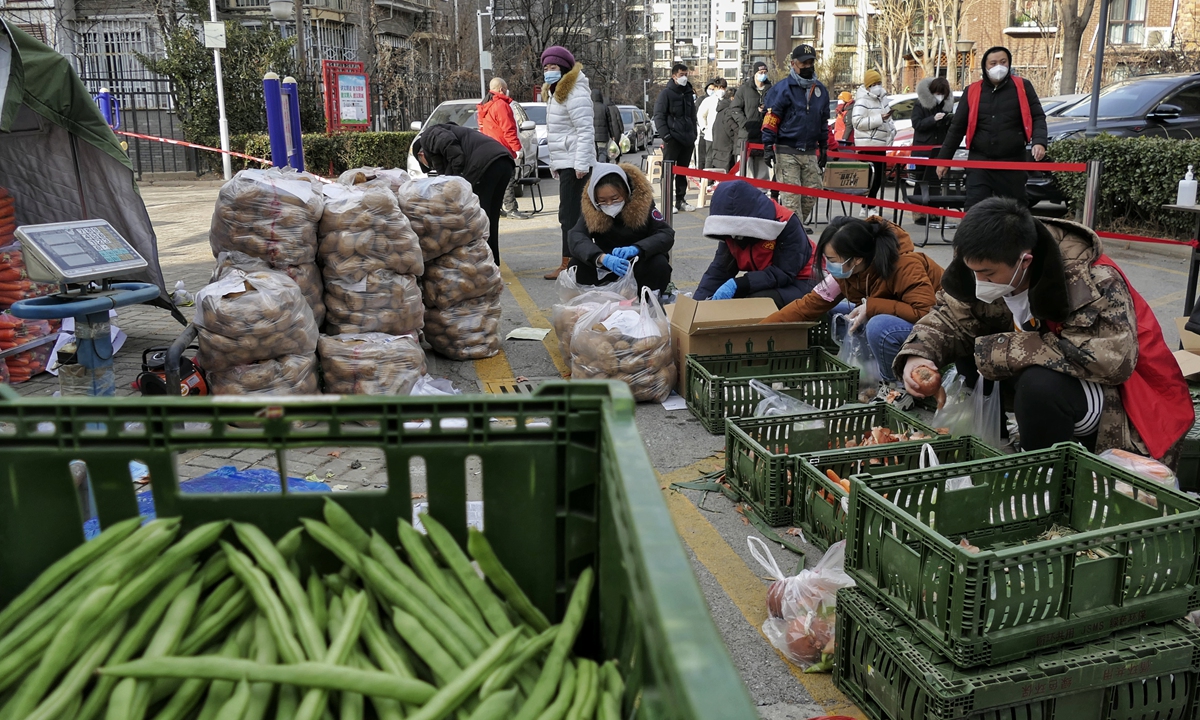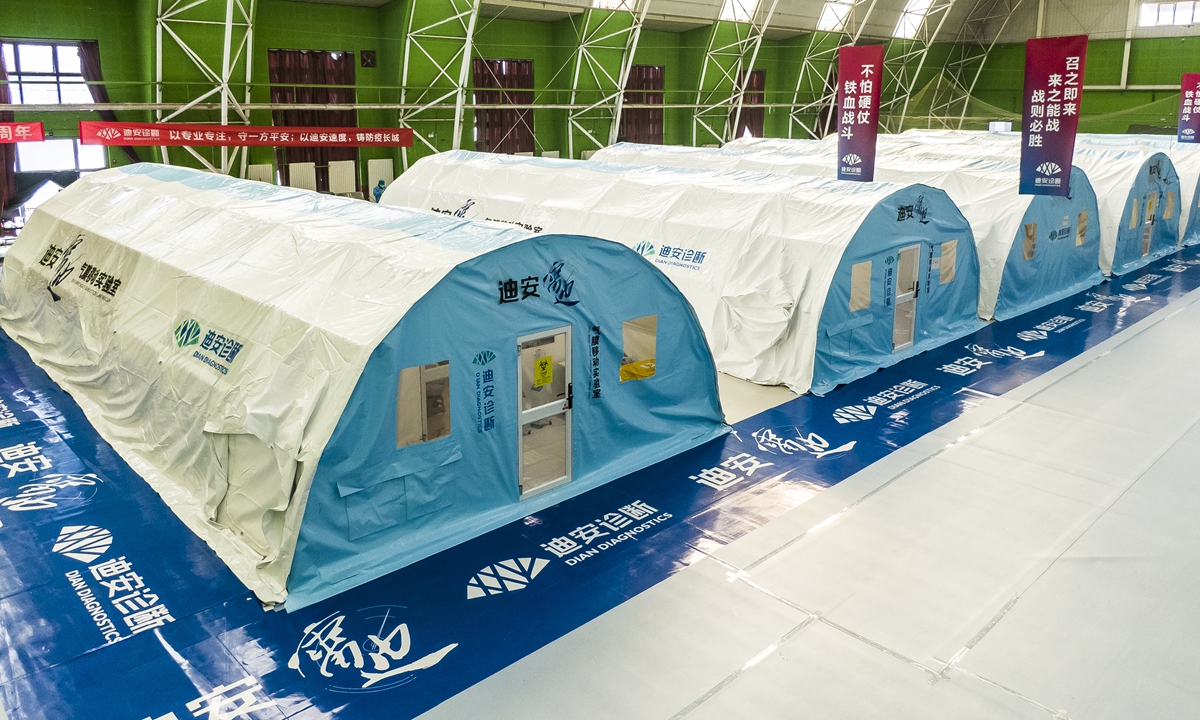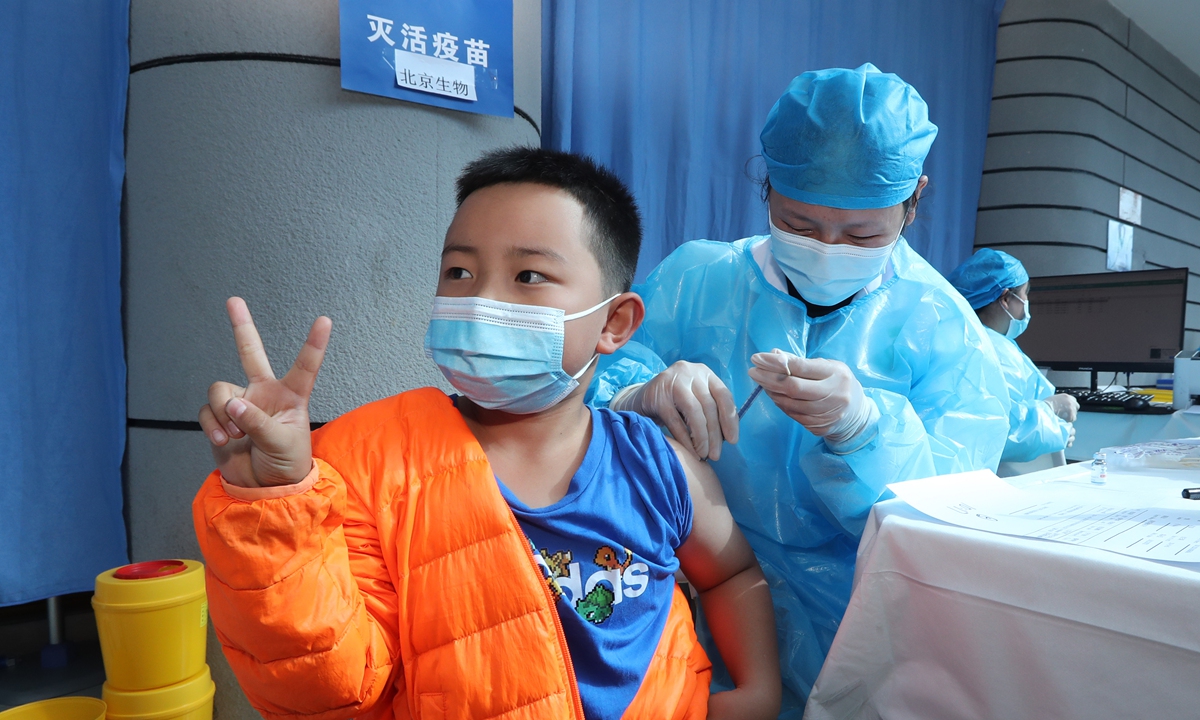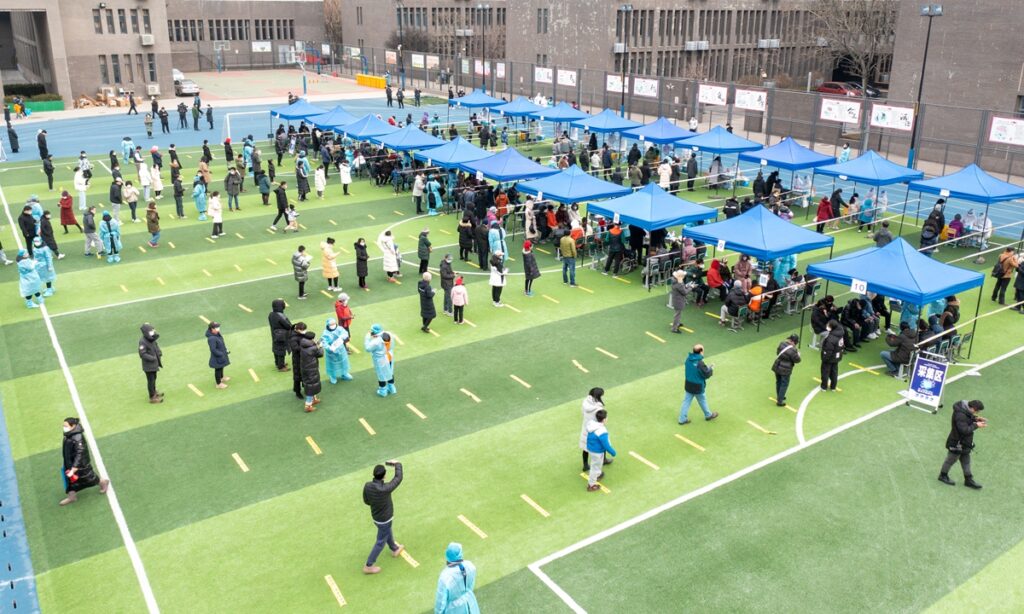Is it possible for a megacity of 14 million people to complete a citywide nucleic acid test screening against the coronavirus disease within about two days? North China’s Tianjin Municipality says “Yes!”
Tianjin, a major gateway to Beijing, has become the epitome of China’s miracle of speed in containing the virus from further spread amid the first real battle against Omicron on the Chinese mainland as domestically-transmitted cases linked to the strain were discovered in Tianjin’s local communities for the first time.
While nucleic acid testing systems in many places in the US have been on the verge of collapse due to a system overload, China’s orderly and efficient community grid management in large-scale testing reflects China’s determination to win the battle against the virus, as well as the efficient response measures continuously refined in the wake of every sudden outbreak, said the experts.
The first round of nucleic acid test screening in Tianjin, which started on January 9, the second day that two local Omicron cases were reported, has concluded with more than 12 million samples collected, resulting in 77 positive cases. The second round started at 12pm on January 12, and more than 2.23 million people had been sampled by 4pm. As of 2pm on Thursday, Tianjin had reported a total of 126 locally confirmed COVID-19 cases and 22 asymptomatic cases.
Well-organized scheduling to avoid long queues in chilly winter weather, quick channels set for vulnerable groups, door-to-door notification – Tianjin’s community-based screening campaign, which started right after local Omicron cases were confirmed, has received a flood of praise from netizens. An efficient and speedy screening is the most powerful weapon to win the fight against Omicron, Wei Sheng, a department head at the Tongji Medical College, Huazhong University of Science and Technology, told the Global Times.
“Current studies show that the Omicron strain is both more transmissible and imperceptible, and the symptoms of infected people are not very prominent. The screening of infected persons can be completed efficiently and quickly and can become the key to curbing the spread of the epidemic.”
At the meeting of the working group of the Joint Prevention & Control Mechanism of the State Council with local officials on January 11, the Party secretary and the mayor of Tianjin stressed efficiency several times, including measures of accelerating the testing capacity and efficiency, as well as expanding the number of isolation points as soon as possible.
How was super-speed community screening achieved?
The Global Times found that Tianjin communities have had nucleic testing booths extensively deployed to allow for residents to have a nearby testing site in designated timeslots under the instructions of volunteers. “Residents in each building in our community go downstairs for testing in real-time sequences, in groups of ten. Community workers also mobilize people in a jovial and relaxed way with Tianjin crosstalk, making us feel no pressure, and no panic at all,” Wu Li, a Tianjin resident told the Global Times.
Typically, residents’ digital health code would turn green from orange if they get a negative nucleic acid test result, said Wu.
Tianjin residents reached by the Global Times said that the second round of large-scale nucleic acid testing on Wednesday improved a lot in the overall organization. Most of their testing process took only about 10 minutes. “We are required to keep a one-meter distance while lining up, and everything was greatly promoted compared to the first round of testing which often saw long queues and waits,” said a resident surnamed Han.

Community workers pack vegetables for residents at a supplies support site in Dasi town in Tianjin on January 12, 2022. Photo: IC
Local authorities set up storage centers to ensure that all kinds of supplies at the quarantine and nucleic acid testing sites are updated at all times, Song Xiaobo, a volunteer in charge of nucleic acid test screening and logistics support, told the Global Times.
“Our village also arranged for commissioners to ensure the supply of food and hot water to the people in the village. Temperature in Tianjin has dropped continuously in recent days. We also distributed heating pad to those who lined up for the nucleic acid test to keep warm,” he said.
Moreover, information on waiting times at over 51 fever clinics and 40 nucleic acid testing sites in Tianjin is updated every two hours on the internet and broadcasted on TV channels, according to media reports. Detailed and timely information has impressed local residents.
Compared with the mass nucleic acid testing carried out in some other cities after sudden outbreaks, it seems that the testing efficiency in Tianjin is almost the highest level that can be achieved at present, thanks to the cooperation of all residents and a strong grass-roots mobilization capacity, said Wei.
“The Omicron strain spreads so fast that we have to figure out how widespread this round of outbreaks is, so we must aim to complete nucleic acid screening across the city within two days,” Zhang Ying, deputy director of Tianjin Center for Disease Control and Prevention, explained in an interview on January 10.
Over the past two years of China’s COVID-19 fight, the entire mass screening process has made great strides, both at the technical and organizational levels, Lu Hongzhou, head of the Third People’s Hospital of Shenzhen and member of the expert committee of Shenzhen epidemic prevention and control center, told the Global Times.
Lu said that China’s capacity in nucleic acid testing has been greatly improved. “Currently, cities are adopting a combination of mixed and individual testing, with individual testing for key populations and mixed testing for secondary key populations such as close contacts, followed by individual testing and review if a positive result is found, ensuring both speed and efficiency.”
National support is also the backbone of Tianjin’s quick response. The working group for epidemic prevention and control of the State Council arrived in Tianjin on January 9.
“Once an outbreak occurs in a place, the government would issue an order to dispatch a national expert team to provide support as soon as possible, and assist in the tracing of the transmission chain of the epidemic within 24 hours,” Wu Liangyou, deputy director of the Disease Control and Prevention Bureau under the National Health Commission, said at a press conference on November 20, 2021.
Strong technology guarantee
During the epidemic resurgence, health code scans topped 10 million. Using big data technology, Tianjin successfully set up an end-to-end “health code – venue code” evaluation model to monitor and evaluate the code information dynamically in real time and optimize it quickly, which significantly reduced the confirmation delay to less than 55 milliseconds on average when the code scan volume doubled, according to media reports. Until now, local telecom operator China Mobile Tianjin has amended 721 network faults, guaranteeing a success rate of health code scans at over 94 percent. The city has deployed a total of 6,066 on-site communication security personnel to provide support during the epidemic flare-up.
High technology has widely been used in the current war against Omicron in Tianjin. 5G and big data, as part of the country’s fast and stable information transmission system, provide an effective support for the management of important tasks during outbreaks in China. For instance, the whole process of nucleic acid testing, including sample collection, sealing, and transportation is recorded digitally.
The cutting-edge air dome labs can enable testing of up to 1.2 million nucleic acid samples daily per lab, which has greatly accelerated the testing speed. Between 2pm to 11.30pm on Wednesday, the lab had received 90,000 tube samples and released about 50,000 results, local media reported. Song was also impressed by the optimized mechanisms during his volunteer experience. “Especially the improvement in the registration process for nucleic acid testing information,” Song told the Global Times, noting that the first round of nucleic acid testing in Tianjin required people to scan two QR codes to fill in information on their mobile phones, which was inconvenient for the elderly and children without mobile phones, for whom the whole process took a long time. “Relevant departments found the problem in time and made adjustments quickly,” he said.

The Dian air dome rapid mobile diagnostics laboratories in use in Tianjin Binhai New Area on January 11, 2022. Photo: IC
“At present, in the process of nucleic acid testing, registration is carried out by skilled collectors with a special APP, and citizens can register the required medical information only with a swipe of their ID card, greatly increasing the speed of testing,” Song noted.
For future improvement, some experts suggest using nasopharyngeal screening more, which can improve the accuracy of the tests, as the oropharynx screening is prone to false negatives.
Experts also called for an increased capacity in epidemiologic surveys nationwide. “An epidemiologic survey requires no overnight stay. Once a positive case is found, the epidemiologic survey team starts working immediately,” Lu told the Global Times. “Experience has been accumulated during the past two years.”
In the future, if conditions permit, other testing methods, such as antigen-testing kits, should be combined to encourage people to take self-tests, which usually take half an hour to provide results, Wei said. Once positive cases are reported, isolated and verified by nucleic acid tests, the detection efficiency can be further improved.

Medical staff give COVID-19 vaccines to students in Kunming, Yunnan Province on November 6, 2021.
China speed proven again in confronting recent COVID-19 outbreaks
“China speed” has made many records in various fields during the country’s journey of development, such as its infrastructure expansion and its bullet trains. China’s fast reaction in response to COVID-19 outbreaks is also great proof of “China speed,” which shows the system advantage to coordinating all efforts to complete key national undertakings.
1.Nucleic acid tests
Tianjin Municipality: Starting from 7am, January 9, in just three days, more than 12 million residents were tested and received immediate results.
Zhengzhou, Henan Province: The city concluded a mass round of testing for its 12.5 million residents in just six hours on January 7, which means the city tested about 2.1 million people per hour, or 583 people per second!
Qingdao, Shandong Province: In October 2021, the coastal port city tested 10 million people in five days before it ruled out the risk of community transmission in a small outbreak.
Guangzhou, Guangdong Province: In June 2021, the city tested 18.7 million in three days.
2 High-techs
5G and big data: The country’s fast and stable information transmission system provides an effective support for the management of important tasks during outbreaks in China. For instance, the whole process of nucleic acid testing, including sample collection, sealing, and transportation is recorded digitally.
Air dome labs: One lab could test 1.2 million nucleic acid samples daily. The technology is now used in Tianjin.
3 Vaccinations
China has undergone one of the world’s most efficient vaccination programs. More than 2.9 billion COVID-19 vaccine doses had been administered on the Chinese mainland as of Monday.
Residents line up to undergo nucleic acid testing in a playground in Tianjin Municipality on January 9, 2022. Photo: VCG



